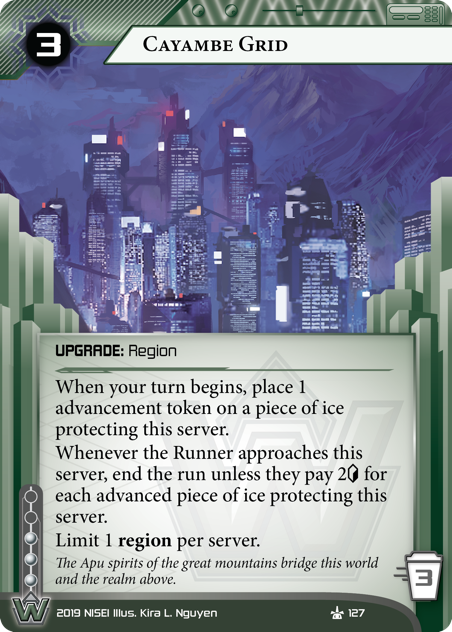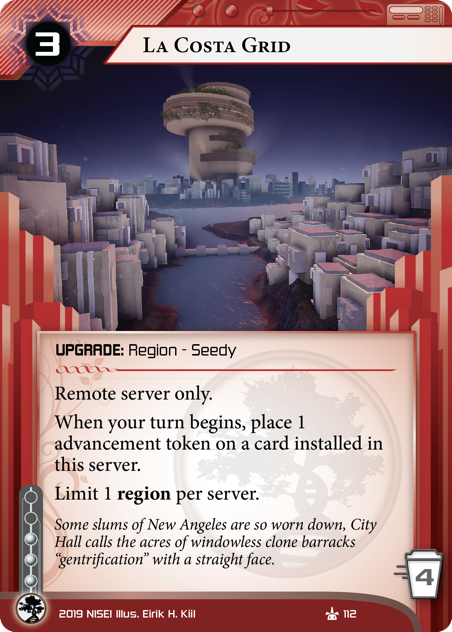Hello there, everyone! It’s been many months since I’ve had something up on the blog here, but I’m excited about what I’m here to talk about today. Very excited indeed.
As you may already be aware, NISEI has decided to release a small selection of cards from our upcoming set, Uprising, a little bit early in order to add a little extra spice to our first World Championship. Seven cards, to be precise – one from each main faction. You can read the original announcement over here, if you haven’t already seen it, and then join me on a short dive into these seven cards and how they came to be!
We’ll be releasing these onto Jinteki.net later today, and as a Print & Play PDF next week alongside the next MWL update. They will become legal for tournament play on the same day as the MWL will come into force, giving you ample time to practise playing them in your deck before the World Championship. Also don’t forget that everyone attending will receive a gorgeous set of full-bleed versions of these cards to use at the championship and take home! Seriously, the art in Uprising is phenomenal and I hope this early peek at the set gets you as excited for the artistic flavours of the cards as much as their mechanical crunch.
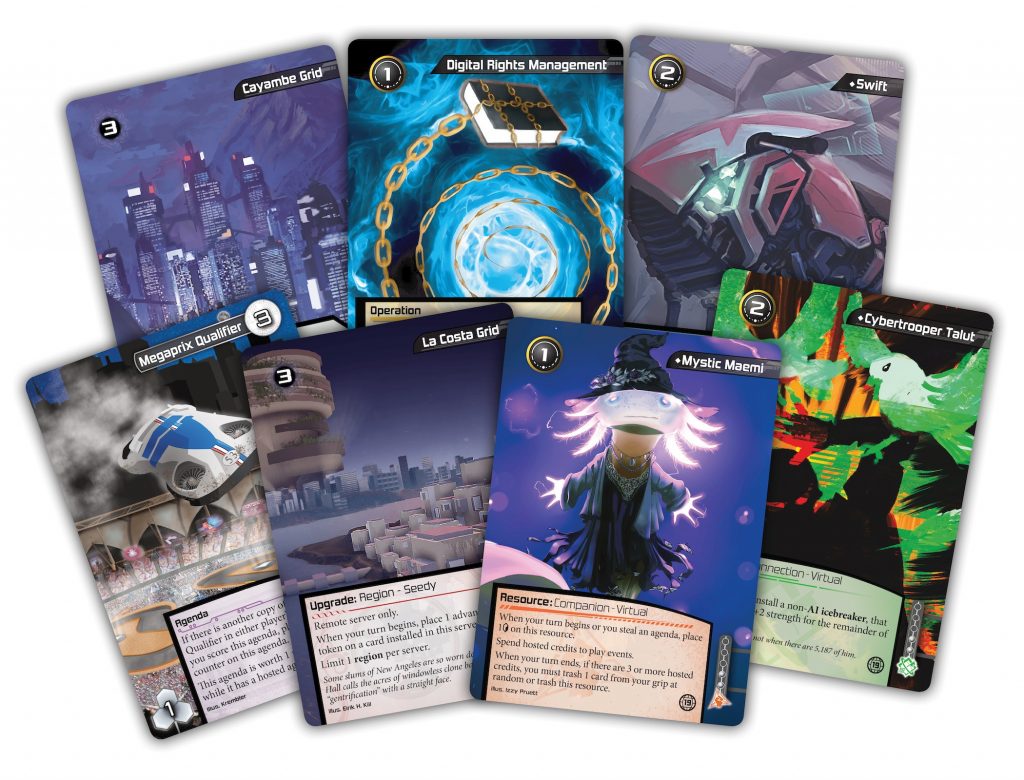
With that tantalising display of the incredible card art we have in Uprising, I’ve got one last thing to mention before I get to the cards themselves! If you didn’t get a chance to read my Downfall Development Rundown earlier this year, I hope you’ll consider doing so now, as it provides some insight into our card development process. I won’t be repeating much of what I explained in that article, mind you, so it’s still worth checking out again if you’re curious.
One of the key differences between the development of Downfall and Uprising is that this is, well, our second set, and the second set of a cycle to boot! There are a lot of cards in Uprising that round out some of the concepts and ideas that began in Downfall, and because we’ve been able to refine our development and playtesting processes, I believe that Uprising is even more polished and balanced than Downfall was!
What is particularly interesting about Uprising is how many of the cards shifted and changed in response to how Downfall played out in the wild. It was also fascinating to be able to playtest the two halves of the cycle together for an extended period of time. So, in addition to the reveal of these seven Booster Pack cards, I thought it might be fun to talk about just that: the individual stories of these seven cards and how they came to be what they are today.
First up is Mystic Maemi, the third of our new Companion subtype resources.
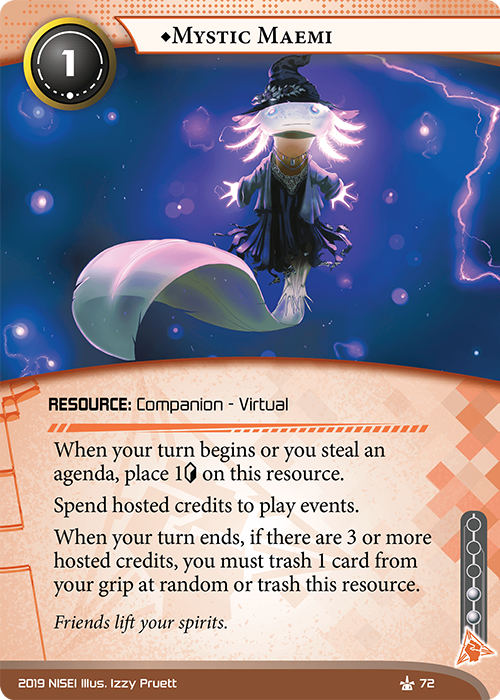
As I talked about in my Downfall article, the Companions proved to be rather tricky cards to sort out as a whole. They have a lot of moving pieces and different abilities that mesh together to enable their functionality. While Trickster is clearly a niche but solid card, Fencer definitely hasn’t turned out to be as useful as we would’ve liked. Mystic Maemi, however, is one of the least changed cards in the entire cycle. While the precise nature of how Fencer functioned saw some changes, Mystic has been almost exactly the same since its initial prototype (aside from the overall Companion changes), and only required some install cost tweaks until we ultimately arrived at 1 credit.
One thing worth noting is that its downside is specifically discarding cards rather than taking damage. I’m sure the Clan Vengeance enthusiasts out there will be disappointed, but this was very much a conscious choice to prevent an easy route to activating self-damage effects for an indefinite period of time. While CV is hardly the powerhouse of pain it was during the Zer0 era, we’d rather not feel limited by what sorts of cards we can make that interact with self-damage in the future.
Mystic isn’t the final Companion either, which I am sure will please those fond of our first two fabulous friends. We have not just one, but two other Companions in the set, and one of them comes in a form I imagine many players might not expect! I’ll be excited to talk about the development process for both of those in the future, as their cycles of birth and rebirth were very complicated indeed!
Next up is the already spoiled Criminal clone’s console, Swift!

I was pretty excited by the initial prototype of Swift we were given at the start of Ashes’ development. Here was another straightforward, run-based console for crim that could rival Paragon for broad application. Very early in testing we identified that the most significant aspect of Swift was its 2 credit install cost. With an up-front cost that won’t slow you down and the ability to immediately get a big benefit from it the turn you play it, the card immediately became very popular with playtesters.
Ultimately the card ended up very similar to its prototype, but it also gave us a good lesson in experimentation with powerful additional effects on consoles. During development, we considered giving Swift a trashcan effect: an ability to trash your console (and potentially a program with the sudden loss of memory) to make an instant run. This was a bit of a riff from an idea Design had given us earlier in development, one that was ultimately scrapped due to timing issues.
The idea had thematic strength: you’re speeding down the highway trying to lose the corporate cronies chasing you. You veer off down a suburban street and notice a small emergency terminal near an alley. With quick thinking and almost reckless abandon, you hurl yourself off your speeding bike and watch as it careens into a nearby wall in a fiery blaze. You hit the ground running, and use the sudden distraction of the explosion as cover to make one quick run back in to try and cover your tracks from your foiled incursion earlier.
We quickly discovered that while the concept was extremely rad it carried with it a host of practical issues. To ensure it was only usable on your turn, and not during an existing run, we had to saddle the ability with constraints and restrictions. Even when we did figure out a way to make that marginally sleeker, the card became hilariously powerful in the likes of Apocalypse archetypes without an easy solution to that balance issue.
There are, without question, moments where fun and stylish abilities just cause more harm than good and weigh down a card with excess complexity or constraints. At the end of the day, the Swift that we’ve ended up with is a sleeker, faster vehicle for Criminal aggression and tempo than the stylish yet wordy versions that preceded it.
Rounding out the Runner-side options is Cybertrooper Talut, our Shaper card for this package.
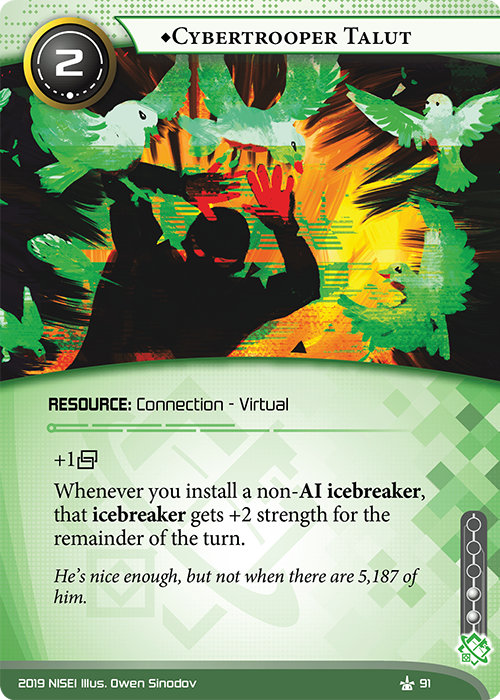
Cybertrooper had a bit of a tricky development history. Initially the card was conceived as a sort of Shaper-style replacement for the soon-to-rotate D4v1d. The card would allow you to trash it to use an icebreaker during an encounter regardless of its strength relative to the strength of a targeted piece of ice. While this felt very Shaper and paired very well with a new icebreaker in Uprising (which was ultimately cut for other unrelated reasons), it had some real issues right from conception.
The requirement to have a relevant icebreaker to use it with is already significantly different from D4v1d, and even though Shapers often have access to tutor effects such as Self-Modifying Code, the strict limit of a single ice at a time made for a drastic reduction in flexibility. We tried several iterations of the card that included an additional passive ability (which eventually became the final passive ability), but ultimately cut the trash ability in exchange for the +1 link.
The decision to move to a more permanent card came hand in hand with the decision to give it the Connection subtype, a choice connected to another Shaper card in Uprising that I am particularly keen to talk about closer to Uprising’s full release! This ultimately gives us a card that provides two passive bonuses, and ties in directly with the mechanical theme given to Shaper this cycle: temporary, powerful bonuses for icebreakers. The theme for this card is also stellar, with its startlingly evocative artwork and profoundly fascinating name.
To begin our dive into the Corporation side of things, we’ll start with one of two new Haas-Bioroid agendas that are coming in Uprising: Megaprix Qualifier!
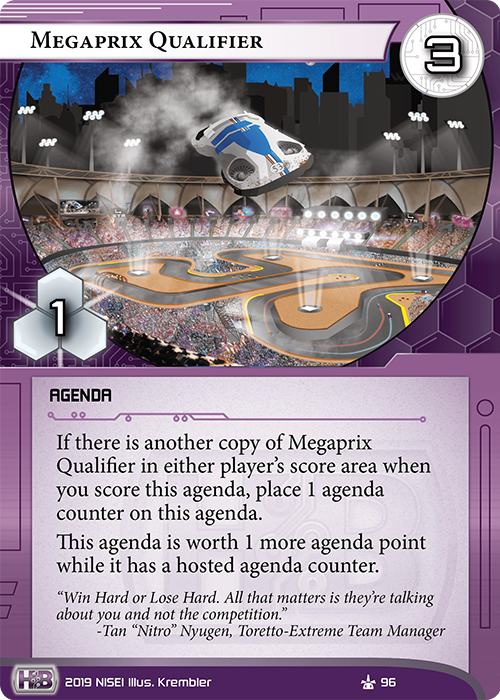
I imagine this card has players fond of a certain sports-themed HB identity already wrapping their brains around its potential. In fact, we were so certain of this that part way through the development cycle the folks over at the Creative Team decided to re-theme the card to better match with Sportsmetal!
Megaprix is a curious case of card development leaning away from higher variance and more towards consistency. Originally the agenda scaled incrementally, rather than getting a single agenda point increase (that is, 1/2/3 points for each one scored) but only checked for copies of itself in the Corp’s score area. This is obviously very potent, allowing you to effectively put three more copies of a 3/2 into your deck, but it also required you to score every single one to get that total effect.
This is clearly a case of very high variance; being able to fast advance a 3 point agenda from your hand to close out a game is incredibly powerful, but it comes at the cost of that only happening if you’re able to find each copy of the agenda in your deck and also not have any of them stolen. Playtester feedback was lukewarm at best, because of this demand for the Corp to get the most out of the card.
The solution, I feel, keeps the excitement while reducing the randomness: we lowered the overall potential of the card to a consistent 2 points, but allowed it to function no matter which player gets the very first copy. This leans incredibly well into how Sportsmetal is constructed as well, with agendas that the Corp isn’t too fussed to lose a couple of, and effects that interact with the Runner having stolen agendas.
The card does of course have powerful applications outside of fast advance decks! With the ability to start threatening more 2 point agendas in addition to Project Vitruvius, the never-advance style of HB is enhanced even further. We’re hoping that this will give a noticeable boost to the faction in time for Worlds, opening up several different routes to capitalise on its strengths.
We’re going to skip over Jinteki for the moment and go straight to NBN here, as I’d like to talk about Digital Rights Management!
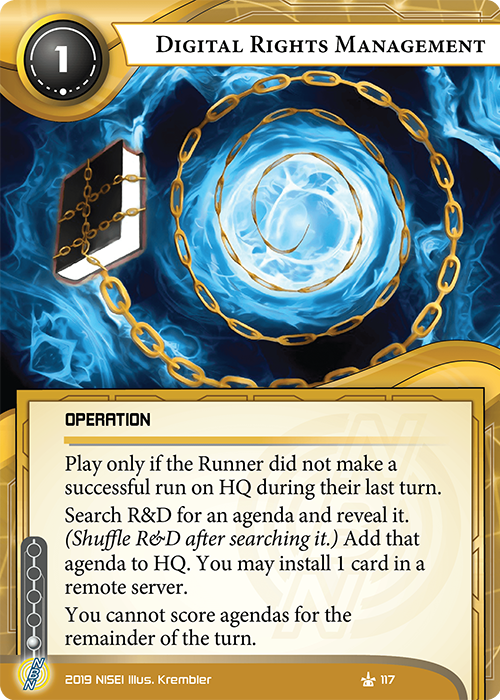
Ah yes, DRM. This card was easily one of the trickiest ones we had through development of Uprising, but also one of my favourite bits of collaborative design within the Dev team. The original prototype of DRM that Design provided to us was sort of like a smaller version of Midseason Replacements, a card that would give the Runner a number of tags after they’ve stolen an agenda. It’s a tough act to follow, as not only was the original Midseason extremely strong, it was also a very pure design and we already have the tagging powerhouse that is Hard-Hitting News. Attempting to create a new tagging card that was both balanced and playable for the current cardpool seemed difficult and potentially excessive.
Both Dev and Design offered some alternative concepts, including some ideas that ultimately formed part of the basis for Downfall’s Game Over, but it wasn’t until one quiet evening that we hit on a firm concept for DRM itself. We’d been discussing the merits of offensive, attacking cards for NBN. Cards that would somehow hurt the Runner, and in particular cards that were intended to hurt Runners for playing strategies that weren’t interactive or particularly proactive. Give tags if they didn’t run, for how many cards they installed, force them to run next turn or take tags. That sort of thing.
The most significant question in my mind was what our goal for the card was. Did we want to provide a way for the Corp to punish the Runner for inaction, or did we simply want a beneficial card that was contingent on Runner inaction? From here it becomes a matter of what I tend to refer to as ‘carrot vs. stick design’; the decision point between making a mechanic something that punishes your opponent for doing something, or one that gives you a boost when they do that thing instead.
The idea of ‘carrot’ based design is that a card rewards rather than punishes, it’s a card that pushes its player forward rather than dragging their opponent back. While there’s absolutely space for the ‘stick’ type of card in ANR, there’s also a great need for carrots on the Corp side in the current meta. We’ve long had a meta that is well defined by flatline strategies, with the likes of Outfit, Argus, Gagarin, IG and even some NBN variants reigning supreme at the top tables. Runners have had to ensure their decks are prepared to deal with those kinds of threats, and over time it has largely become an arms race that is all about corporate speed-murder against suffocating Shaper control and Misdirection.
Some of those developments didn’t come until long after we settled on this direction for DRM, but I can say now that I’m really glad we’re providing a way for Corps who want to pursue a scoring victory to accelerate their game plan against Runners who are sitting back and waiting for the Corp to find their pieces. In the end, the Dev team put our heads together and followed the thought through to the conclusion that became DRM. What would help slower Corps fight sit-back Runners? Speed. What helps with speed? Finding the agendas you need to win when you have an opening. Fast Track helps, but doesn’t help with 5/3s, so why don’t we make something that can.
Of particular note is how DRM compares to Fast Track: now you can pull a 5/3 from R&D and threaten to score it immediately. Azmari, SSO, The Outfit, and other archetypes who want to either rush out or play a lower agenda density with 5/3s can leverage DRM to smooth out of their game plan.
There was also a point where you could fast advance using DRM during playtest… Those were dark days in conjunction with some older iterations of other Uprising cards. While many of those cards were either cut or changed dramatically, we still ultimately felt this limitation keeps the card squarely in the desired zone of usage and future-proofs it should we push fast advance tools further in the future.
While we’re on the topic of trying to provide non-flatline threats for corporations, let’s talk about both the new Jinteki and new Weyland cards together. La Costa Grid for Jinteki, and Cayambe Grid for Weyland!
There’s been a lot of clamouring in both playtest and the wider community for more defensive or threatening upgrades to exist in the game. There has been much lamenting about the loss of the likes of Caprice Nisei or SanSan City Grid ever since the first FFG rotation hit, and we’ve been keenly aware of that during the development of Ashes. While perhaps not every card in that category is beloved by every player out there, I think few would deny the hole in the corporate toolbox where those older cards used to fit.
Both of these cards were reworked wholecloth from their original prototypes to suit needs that we discovered during early playtesting. The card that La Costa replaced was an asset that we’ve put in the slush file for the future when we’re more confident of implementing it correctly. Cayambe took the place of an upgrade that playtest broke over their collective knees within a week of playtesting, while we folded the major ideas of that upgrade into another card in Uprising.
The route which we take for these sorts of cards is usually where we flex our ability to communicate and compromise the most. We come up with ideas and needs, and take them to the Design team. They give feedback, or suggest other concepts. We refine them, and talk to both the Rules team (can this work?) and the Creative team (can this fit within the existing theme? Is it okay to ask for it to be changed?) until everyone is satisfied with our rework. Then we get to set our new ideas loose into playtest and watch them be (probably) torn apart. I love our playtesters.
La Costa Grid was the brainchild of @divadus, who wanted a powerful card for Jinteki glacier that would provide multiple avenues of tempo or threat. With La Costa on the board, any card in its server can be a Nisei Mk. II, a Corporate Sales Team or even a [REDACTED], something the Runner can’t ignore. The surprise factor of install, install, and then playing an IPO or suchlike can get you one of those agendas out of nowhere, as well. Not to be underestimated is its ability to charge up Bio Vault for free during your off turns, as well, either allowing you to protect your region or your next agenda if the Runner leaves it alone.
There’s definitely some wacky shenanigans possible with Political Dealings and the likes of Rashida Jaheem or other start-of-turn draw effects, too.
Cayambe Grid started out as a fairly simple economy upgrade, offering recurring credits with which to advance cards in or protecting its server. While… neat, its practical applications were somewhat minimal and we began the lengthy process of finding a way to enable the card to provide both an economic boost and a defensive capability. This was a very tricky process indeed, as the constraints of text length, complexity, and timing issues were tough problems to repeatedly tackle.
While numerically the card’s taxing ability might not immediately seem massive, its ability to power up the ice protecting the server adds up rapidly. SSO in particular is able to leverage the extra tax from Cayambe to close out matches that run longer than they’d like, using their already beefed up ice to increase the tax. The region also pairs very well with Downfall’s Reduced Service and [REDACTED] coming in the full release of Uprising, making your remote servers especially costly to deal with for Runners.
I am delighted with the card we ended up with, and it also spawned a slew of other changes to Weyland in Uprising that tie into a similar mechanical area. I’m sure the SSO and Builder of Nations fans out there will be waiting with keen interest to see what other surprises we have in store. Fans of other Weyland archetypes will have to wait for the full set to drop, but have plenty to look forward to from Uprising, especially the new identity!
That’s it for now, folks, but I hope you’ve enjoyed these insights into the developmental stories of these new cards, as well as seeing the new cards themselves! I’m sure you’ll be hearing from me again in the lead up to Uprising’s actual release later this year. While I won’t be at our World Championship myself, both @divadus and @ZiNOS from the development team will be, and I’ll be watching from across the world with maximum hype to see how these new cards perform on the grandest stage we have.
As a final reminder, these cards will be live on Jinteki.net and NetrunnerDB sometime shortly after this article has been published! Again, we’ll be releasing the next update for the MWL, legal for Worlds, next week, alongside a print-and-play PDF for the regular versions of these seven cards. Until next time, my friends, thank you for reading and I hope to have a chance to deliver some more hot scoops and reflective thoughts soon!

